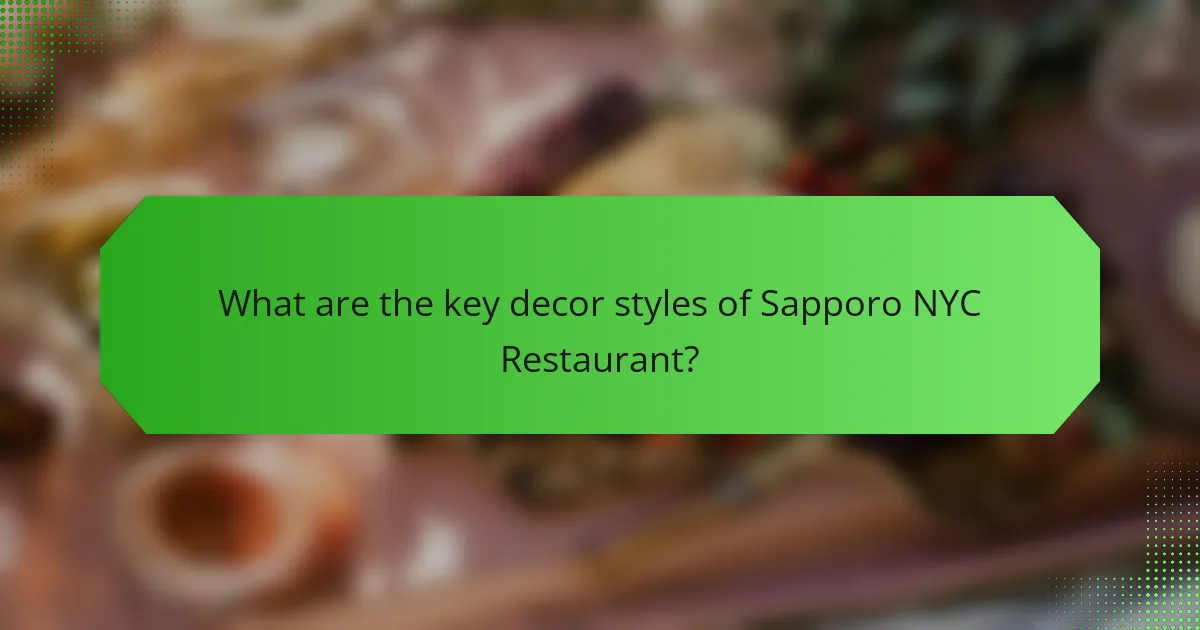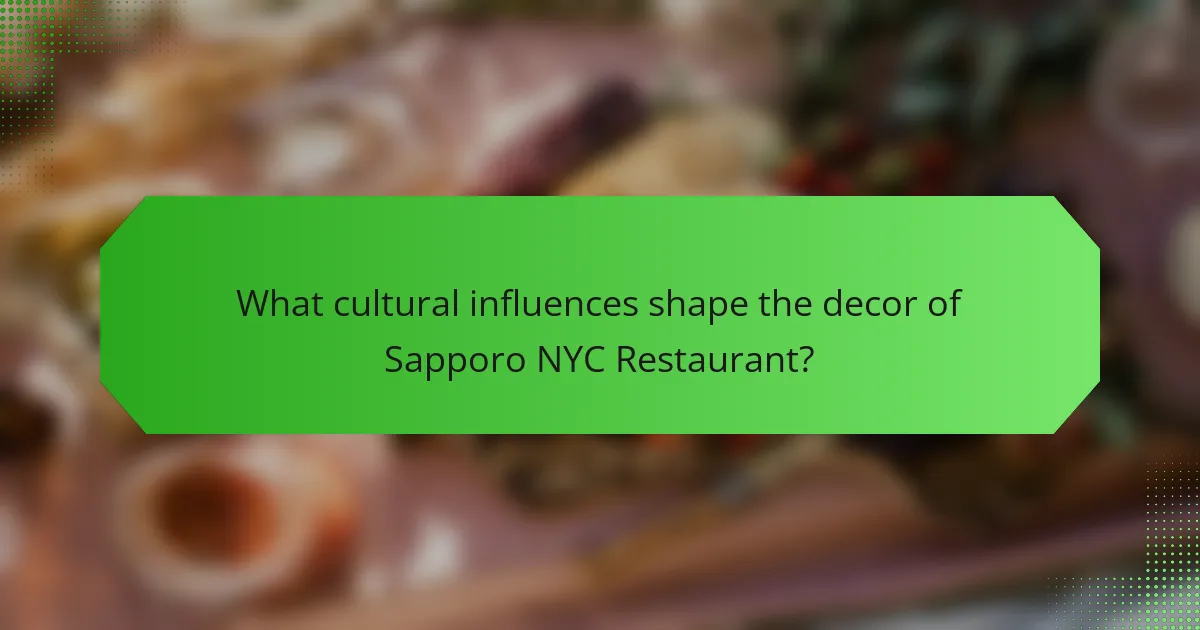
What are the key decor styles of Sapporo NYC Restaurant?
Sapporo NYC Restaurant features a blend of Japanese and modern decor styles. The interior showcases traditional Japanese elements, such as shoji screens and tatami mats. Minimalist design principles are evident throughout the space. Natural materials like wood and stone are prominently used. Ambient lighting creates a warm and inviting atmosphere. Artworks reflecting Japanese culture adorn the walls. The overall aesthetic emphasizes harmony and simplicity. This decor approach enhances the dining experience and aligns with Japanese dining traditions.
How do traditional Japanese influences manifest in the decor?
Traditional Japanese influences manifest in decor through minimalism, natural materials, and harmony with nature. The use of tatami mats is common, providing a natural aesthetic. Shoji screens often divide spaces, allowing light while maintaining privacy. Low furniture, such as low tables and floor cushions, emphasizes comfort and simplicity. Traditional colors like muted earth tones create a calming atmosphere. Japanese artwork, including calligraphy and ink paintings, adds cultural depth. Incorporating bonsai and ikebana reflects a connection to nature. Overall, these elements create a serene and balanced environment, characteristic of Japanese design principles.
What specific elements define traditional Japanese restaurant decor?
Traditional Japanese restaurant decor is defined by simplicity, natural materials, and cultural symbolism. Key elements include wooden furnishings, such as tatami mats and low tables. Shoji screens are often used to create a sense of privacy and tranquility. Traditional lighting features paper lanterns or soft, ambient light. Artwork, such as calligraphy and ink paintings, reflects Japanese aesthetics. Natural elements like bamboo and stone create a harmonious atmosphere. Additionally, the use of seasonal decorations emphasizes the connection to nature. These design choices are rooted in Japanese cultural values, promoting a serene dining experience.
How do these elements enhance the dining experience?
The elements of decor and cultural influences enhance the dining experience by creating an immersive atmosphere. A well-designed space stimulates the senses and sets the mood for the meal. For example, traditional Japanese decor can evoke a sense of authenticity. This connection to culture can deepen guests’ appreciation for the cuisine. Additionally, elements like lighting and artwork contribute to the overall ambiance. Studies show that ambiance can significantly influence customer satisfaction. A pleasant environment encourages longer visits and repeat patronage. In essence, decor and cultural elements transform dining into a memorable experience.
What modern decor styles are incorporated in Sapporo NYC Restaurant?
Sapporo NYC Restaurant incorporates modern decor styles such as minimalist, industrial, and contemporary Asian influences. The minimalist style emphasizes clean lines and uncluttered spaces, creating a serene dining atmosphere. Industrial elements include exposed brick and metal fixtures, adding a raw, urban feel. Contemporary Asian influences are evident in the use of natural materials and subtle color palettes, reflecting the restaurant’s cultural heritage. These decor styles work together to create a unique dining experience that resonates with both modern and traditional aesthetics.
What are the characteristics of contemporary Japanese restaurant design?
Contemporary Japanese restaurant design is characterized by minimalism, natural materials, and harmony with nature. This design approach emphasizes simplicity and functionality. Clean lines and uncluttered spaces are common features. Natural elements like wood, stone, and bamboo are frequently used in construction and decor. Lighting plays a crucial role, often utilizing soft, ambient sources to create a serene atmosphere. Open layouts promote a sense of community and connection among diners. Traditional Japanese aesthetics, such as wabi-sabi, influence the design, celebrating imperfection and transience. These characteristics reflect a balance between modernity and tradition, appealing to both local and international patrons.
How do modern aesthetics blend with traditional elements in Sapporo NYC?
Modern aesthetics in Sapporo NYC blend with traditional elements through a harmonious design approach. The restaurant features sleek lines and minimalist decor that evoke contemporary style. Traditional Japanese motifs, such as shoji screens and tatami mats, are incorporated into the space. This fusion creates a welcoming atmosphere that respects cultural heritage. Natural materials like wood and stone are utilized to enhance both styles. The lighting design combines modern fixtures with warm, traditional lanterns. This interplay creates a unique dining experience that appeals to diverse patrons. Overall, Sapporo NYC exemplifies how modern and traditional elements can coexist beautifully.

What cultural influences shape the decor of Sapporo NYC Restaurant?
Sapporo NYC Restaurant’s decor is influenced by Japanese culture and aesthetics. Traditional Japanese design principles are evident in the restaurant’s use of natural materials. Elements such as wood, stone, and bamboo create an authentic ambiance. The decor features minimalist styles that emphasize simplicity and functionality. Additionally, the restaurant incorporates elements of modern design, blending contemporary art with traditional motifs. Cultural symbols, such as lanterns and calligraphy, enhance the dining experience. The overall aesthetic aims to reflect the essence of Sapporo, Japan, known for its unique blend of urban and natural beauty.
How does Japanese culture influence the overall ambiance?
Japanese culture significantly influences the overall ambiance through its emphasis on simplicity and harmony. Traditional Japanese design incorporates natural materials like wood and stone. These elements create a calming environment that promotes relaxation. Additionally, the concept of ‘wabi-sabi’ values imperfection and transience, contributing to a warm, inviting atmosphere. Japanese aesthetics often include minimalistic decor and soft lighting, enhancing the overall experience. Cultural practices such as tea ceremonies further emphasize mindfulness and tranquility. The integration of these aspects creates a cohesive and serene dining experience in restaurants like Sapporo NYC.
What cultural symbols are represented in the restaurant’s decor?
The restaurant’s decor features various cultural symbols reflecting Japanese heritage. Traditional elements include lanterns that symbolize light and guidance. Additionally, bamboo accents represent strength and flexibility. The use of cherry blossom motifs signifies beauty and the transient nature of life. Furthermore, calligraphy art showcases the importance of language and aesthetics in Japanese culture. Each symbol is carefully chosen to create an authentic atmosphere that honors cultural traditions.
How do these symbols contribute to the restaurant’s identity?
Symbols contribute to the restaurant’s identity by visually representing its cultural themes and values. They create an immediate connection with customers, evoking specific emotions and memories. For example, traditional Japanese motifs enhance the authenticity of Sapporo NYC’s dining experience. These symbols differentiate the restaurant from competitors, establishing a unique brand presence. Additionally, they can reflect the restaurant’s culinary focus, such as using imagery related to sushi or ramen. Overall, symbols reinforce the restaurant’s narrative and help in building customer loyalty.
What role does New York City’s culture play in the decor choices?
New York City’s culture significantly influences decor choices in restaurants. The city is known for its diversity, with various cultural backgrounds represented. This diversity leads to eclectic decor styles that reflect different cultural heritages. For instance, Asian, European, and Latin American influences can be seen in the design elements. The vibrant art scene in New York also inspires unique decor choices. Many restaurants incorporate local art and contemporary design to attract customers. Additionally, historical architecture plays a role in shaping the ambiance. This blend of influences creates a dynamic dining experience that resonates with both locals and tourists.
How does Sapporo NYC integrate local influences into its design?
Sapporo NYC integrates local influences into its design through the use of materials and decor that reflect the surrounding community. The restaurant features artwork from local artists, showcasing New York’s vibrant culture. Additionally, the interior design incorporates elements inspired by Japanese aesthetics, blended with urban New York styles. This fusion creates a unique environment that resonates with both local and Japanese traditions. The use of reclaimed wood and industrial materials further emphasizes the connection to New York’s architectural heritage. Overall, the design reflects a commitment to honoring local culture while maintaining authentic Japanese influences.
What unique features reflect the fusion of NYC and Japanese culture?
Unique features reflecting the fusion of NYC and Japanese culture include architectural styles and culinary innovations. The Sapporo NYC restaurant showcases minimalist design, typical of Japanese aesthetics. This contrasts with the vibrant, eclectic styles of NYC. Traditional Japanese elements, such as shoji screens and tatami mats, are integrated into the decor. The menu features fusion dishes that blend NYC flavors with Japanese techniques. Examples include sushi rolls with local ingredients and ramen with a New York twist. Events like sake tastings highlight cultural exchange. Overall, this fusion creates a unique dining experience that honors both cultures.

How can customers appreciate the decor at Sapporo NYC Restaurant?
Customers can appreciate the decor at Sapporo NYC Restaurant by observing its unique design elements. The restaurant features traditional Japanese aesthetics, including minimalist furniture and natural materials. Customers can notice the use of wood and stone, which reflect Japanese craftsmanship. The lighting creates a warm and inviting atmosphere, enhancing the overall dining experience. Artwork and decor pieces often showcase Japanese culture, adding to the authenticity. Customers may also appreciate the thoughtful arrangement of space, promoting a sense of tranquility. These elements collectively contribute to a culturally rich environment that elevates the dining experience.
What should diners look for in the decor to enhance their experience?
Diners should look for cohesive themes in the decor to enhance their experience. A well-defined theme creates an atmosphere that resonates with the restaurant’s cuisine and culture. For example, Sapporo NYC incorporates Japanese elements like bamboo and paper lanterns. These features evoke a sense of authenticity and connection to the food. Lighting is also crucial; soft, warm lighting can create an inviting ambiance. Additionally, art pieces or cultural symbols can enrich the dining experience by providing visual interest. Comfortable seating arrangements encourage relaxation and enjoyment during meals. Overall, thoughtful decor choices significantly impact diners’ overall satisfaction and engagement.
How can understanding the decor’s cultural significance enrich the dining experience?
Understanding the decor’s cultural significance can greatly enrich the dining experience. It allows diners to connect with the origins of the cuisine being served. For example, traditional Japanese decor elements, such as Shoji screens and tatami mats, reflect the values of simplicity and harmony. This connection can enhance appreciation for the dishes, making them more meaningful. Additionally, knowledge of cultural symbols can foster a deeper respect for the traditions behind the food. Engaging with the decor can create a more immersive atmosphere, encouraging diners to savor their meals. Ultimately, this understanding transforms dining into a holistic cultural experience.
What tips can enhance appreciation of Sapporo NYC’s design elements?
To enhance appreciation of Sapporo NYC’s design elements, focus on the restaurant’s blend of traditional Japanese aesthetics and modern design. Observe the use of natural materials like wood and stone, which reflect Japanese culture. Pay attention to the lighting design that creates a warm and inviting atmosphere. Notice the incorporation of art pieces that represent Japanese heritage. Engage with the layout that promotes a communal dining experience, typical in Japanese culture. Appreciate the color palette, which often features earth tones that evoke tranquility. Lastly, consider the attention to detail in decor, which showcases craftsmanship and enhances the overall dining experience.
Sapporo NYC Restaurant serves as the focal entity of this article, highlighting its decor styles and cultural influences. The restaurant features a blend of traditional Japanese and modern design elements, including minimalist aesthetics, natural materials, and cultural symbols that enhance the dining experience. Key decor aspects include shoji screens, tatami mats, and ambient lighting, which create a serene atmosphere. Additionally, the integration of local New York influences and contemporary art reflects the restaurant’s unique identity, appealing to both locals and visitors. Understanding these elements enriches the overall appreciation of the dining environment and its culinary offerings.


